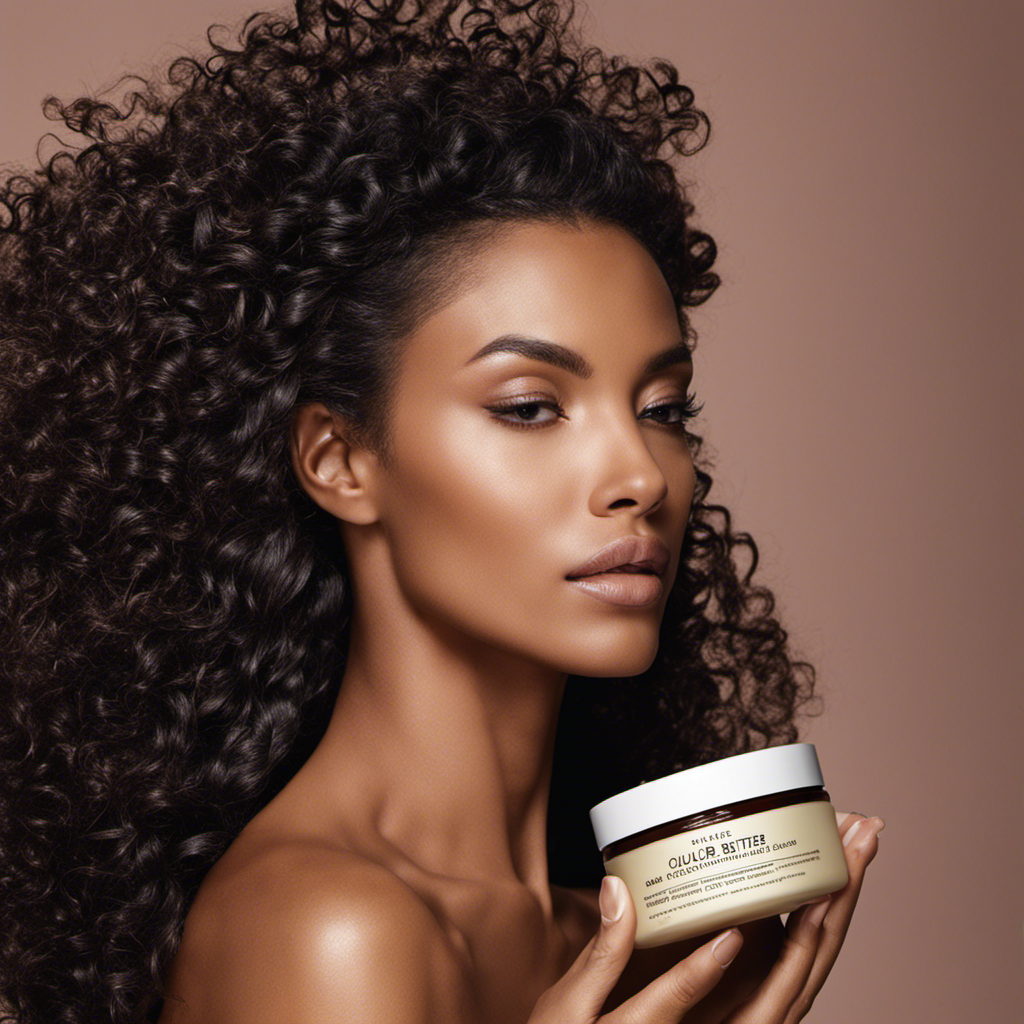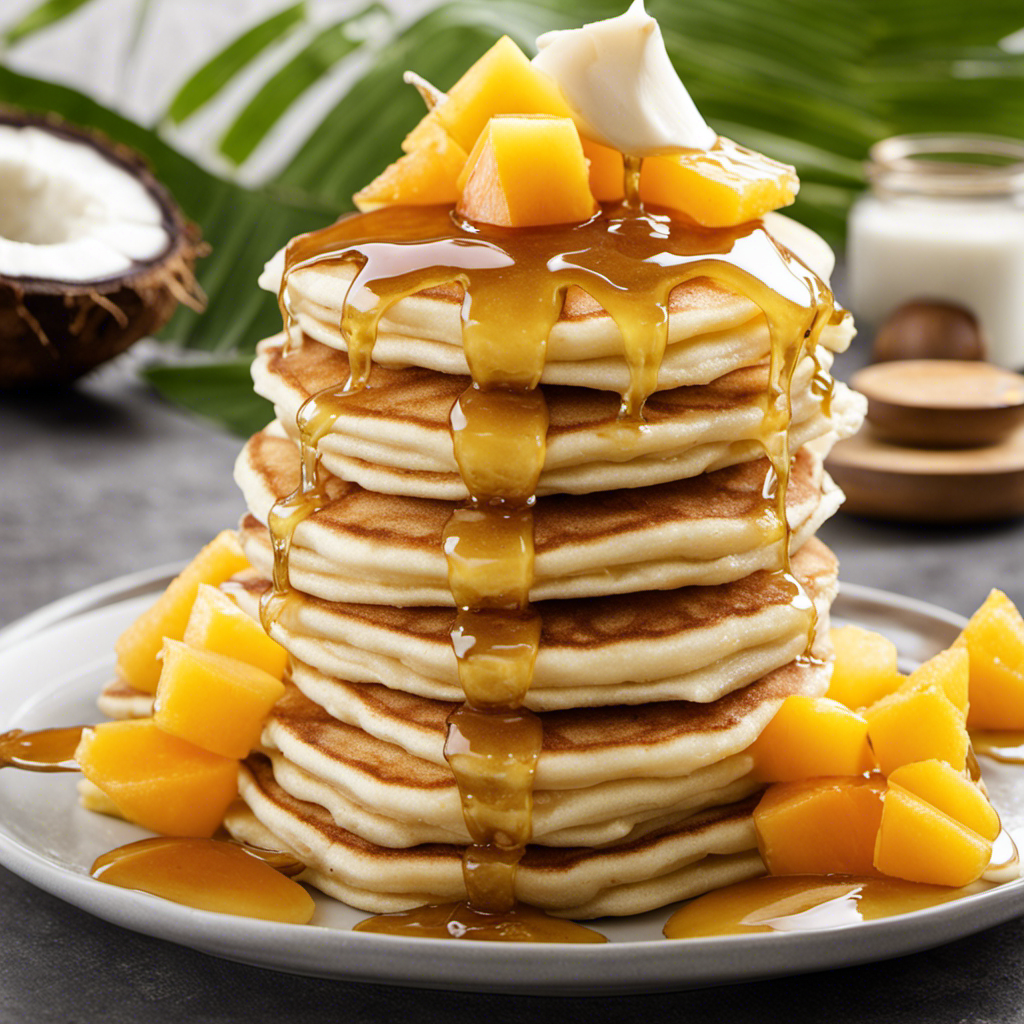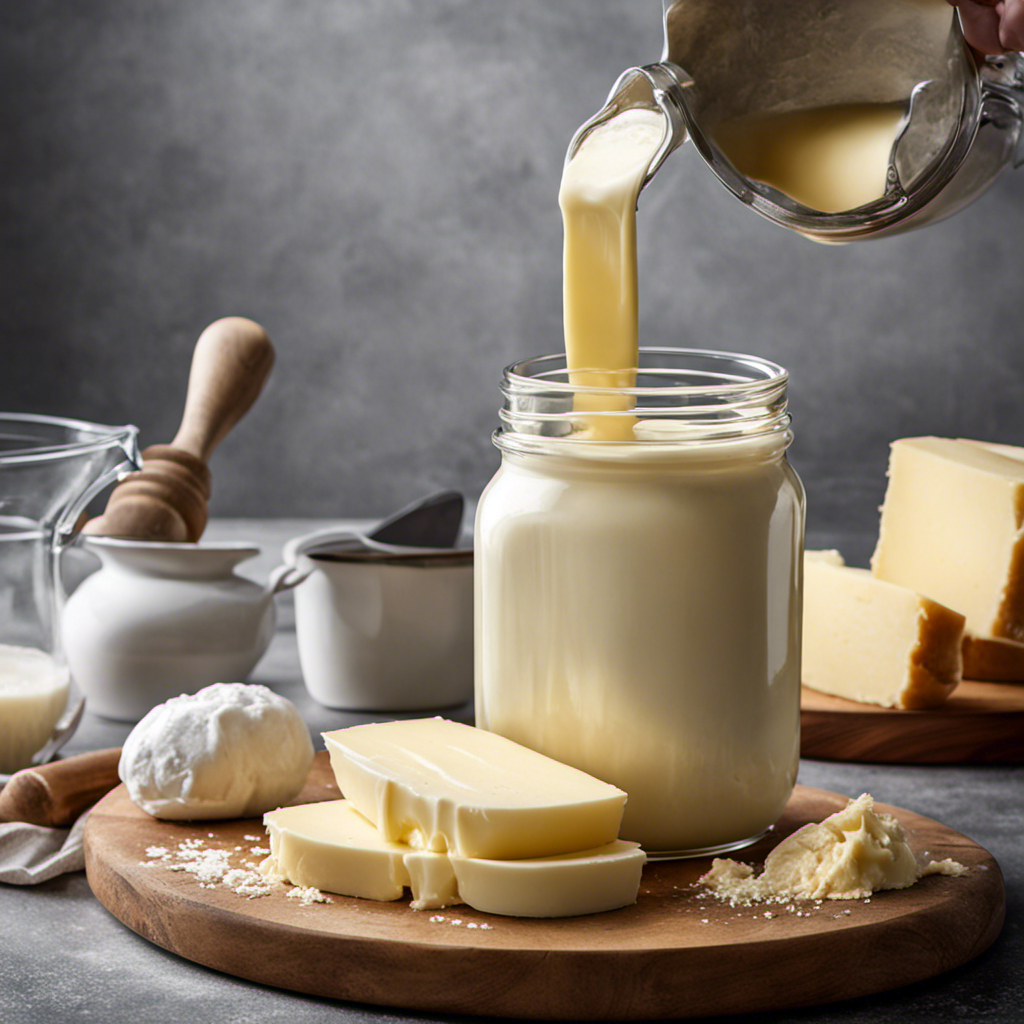Hey! If you’re looking to shake things up in your hair care routine, consider trying hair butter. Believe me, it will make a huge difference.
The benefits are endless, from nourishing your locks to taming frizz. But how do you use it? Don’t worry, I’ve got you covered.
In this article, I’ll walk you through the step-by-step process of using hair butter, from choosing the right one for your hair type to proper application techniques.
Get ready to fall in love with your hair all over again. Let’s dive in!
Key Takeaways
- Hair butter nourishes and moisturizes hair.
- It can be used as a leave-in treatment after washing and conditioning.
- Hair butter can be used as a styling product to enhance curls or smooth down flyaways.
- The frequency of using hair butter depends on factors like hair type, texture, and condition.
Benefits of Hair Butter
Using hair butter can provide you with a multitude of benefits for your hair.
Hair butter, unlike hair oil, is a creamy and thick product that helps nourish and moisturize your hair.
It is rich in natural ingredients like shea butter, coconut oil, and essential oils that deeply penetrate the hair shaft, leaving your hair soft, shiny, and healthy.
Hair butter is especially beneficial for those with dry, damaged, or frizzy hair, as it helps in restoring moisture and reducing breakage.
Not only does hair butter provide hydration, but it also acts as a natural styling product.
It helps define curls, smooth down flyaways, and add shine to your hair, giving it a polished and put-together look.
Whether you have curly, straight, or wavy hair, incorporating hair butter into your hair care routine can make a noticeable difference in the overall health and appearance of your hair.
Choosing the Right Hair Butter for Your Hair Type
When selecting the right hair product for your specific hair type, it’s important to consider the benefits and ingredients of different hair butters.
Hair butters are rich and nourishing, providing numerous benefits for your hair. They can deeply moisturize, soften, and add shine to your locks. Hair butters are also great for taming frizz, reducing breakage, and promoting healthy hair growth.
When choosing a hair butter, it’s essential to look for ingredients that suit your hair’s needs. Natural ingredients like shea butter, coconut oil, and argan oil are excellent choices as they provide intense hydration and nourishment. Avoid products with harsh chemicals and artificial fragrances that can strip your hair of its natural moisture.
Now that you understand the benefits and ingredients of hair butter, let’s move on to preparing your hair before applying it.
Preparing Your Hair Before Applying Hair Butter
Before applying hair butter, make sure to properly prepare your locks by thoroughly washing and conditioning them. This step is crucial in order to maximize the benefits of the hair butter and ensure optimal absorption into the strands.
Here are three essential steps to prepare your hair before applying hair butter:
-
Pre-Shampoo Treatment: Before washing your hair, consider applying a pre-shampoo treatment. This can be done by applying a lightweight oil or conditioner to your hair and leaving it on for a few minutes before rinsing. This will help to nourish and protect your hair, preventing it from becoming dry or brittle during the shampooing process.
-
Detangling Methods: Before applying hair butter, it is important to detangle your hair to minimize breakage and ensure even distribution of the product. Start by gently combing through your hair with a wide-toothed comb or your fingers, starting from the ends and working your way up to the roots. This will help to remove any knots or tangles and ensure that the hair butter can be applied smoothly.
-
Thorough Washing and Conditioning: Before applying hair butter, it is essential to thoroughly cleanse and condition your hair. Use a gentle shampoo to remove any dirt, oil, or product buildup. Follow up with a moisturizing conditioner to nourish and hydrate your strands. This will create a clean and receptive canvas for the hair butter, allowing it to penetrate deeply and effectively.
How to Properly Apply Hair Butter to Your Hair
To ensure optimal application, start by sectioning your hair into smaller parts before evenly distributing the hair butter from root to tip.
Hair butter application is a crucial step in your hair care routine as it provides numerous benefits. Firstly, it deeply moisturizes and nourishes the hair, leaving it soft and manageable. The rich ingredients in hair butter, such as shea butter and essential oils, penetrate the hair shaft, promoting healthy hair growth and preventing breakage. Additionally, hair butter helps to seal in moisture, reducing frizz and enhancing natural shine.
When applying hair butter, make sure to massage it into each section thoroughly, ensuring that every strand is coated. This will result in an even distribution and maximum absorption of the product.
Now that you know how to apply hair butter, let’s move on to some tips for maximizing its effectiveness.
Tips for Maximizing the Effectiveness of Hair Butter
When it comes to maximizing the effectiveness of hair butter, there are three key points to consider: proper application techniques, choosing the right formula, and incorporating it into your haircare routine.
First, understanding the proper application techniques is crucial for achieving the desired results. This includes evenly distributing the product throughout your hair, focusing on the ends, and avoiding the roots to prevent greasiness.
Second, choosing the right formula is essential as different hair types require different ingredients. Whether you have dry, damaged, or curly hair, there is a hair butter formula designed to address your specific needs.
Proper Application Techniques
Once you’ve chosen the right hair butter for your hair type, start by taking a small amount and rub it between your palms. This will help to warm up the product and make it easier to distribute evenly throughout your hair.
Here are three effective techniques for applying hair butter:
-
Section your hair: Divide your hair into smaller sections to ensure that the hair butter is evenly applied from roots to ends. This will help to avoid product buildup and ensure that all strands receive the nourishment they need.
-
Finger combing: Use your fingers to work the hair butter through your hair, starting from the roots and working your way down. This technique allows for better control and helps to distribute the product evenly.
-
Scrunching: If you have curly or wavy hair, scrunching the hair butter into your hair can help to enhance your natural texture and define your curls or waves.
By following these application techniques, you can maximize the benefits of your hair butter and achieve healthier and more nourished hair.
Now, let’s move on to the next section and learn about choosing the right formula for your hair.
Choosing the Right Formula
Now that you’ve learned about applying hair butter, let’s discuss how to choose the right formula for your specific hair type.
Choosing the right hair products can be overwhelming, especially with the wide range of options available. When selecting a hair butter, it’s important to consider your specific hair concerns.
If you have dry and damaged hair, look for a formula that is rich in moisturizing ingredients like shea butter or argan oil.
For those with oily hair, opt for a lightweight formula that won’t weigh your hair down.
If you have frizzy or unruly hair, choose a hair butter that contains smoothing agents like coconut oil or jojoba oil.
Additionally, if you have colored or chemically treated hair, go for a formula that is specifically formulated for color protection.
Incorporating Into Haircare Routine
To effectively incorporate hair butter into your haircare routine, start by applying a small amount of the product to your palms. Then, distribute it evenly through your damp or dry hair. This step is crucial for maintaining hair health and achieving the best results.
Here are three important tips to consider when incorporating hair butter into your routine:
-
Use it as a leave-in treatment: Hair butter can act as a nourishing leave-in conditioner. Apply it to your hair after washing and conditioning, focusing on the ends and any areas that need extra hydration.
-
Seal in moisture: After applying your regular moisturizer or oil, seal it in with hair butter. This will help lock in moisture and prevent dryness and frizz.
-
Style with hair butter: Hair butter can also be used as a styling product. Apply a small amount to your fingertips and scrunch it into your curls or use it to smooth down flyaways and add shine.
Incorporating hair butter into your routine is a simple yet effective way to maintain hair health and achieve the desired results.
How Often Should You Use Hair Butter
You should use hair butter as often as your hair needs it, ensuring that you don’t overdo it and weigh your hair down. Hair butter can be a great addition to your haircare routine, providing nourishment and moisture to your strands.
The frequency of using hair butter depends on various factors such as your hair type, texture, and overall condition. If you have dry or damaged hair, you may benefit from using hair butter more frequently, perhaps 2-3 times a week. However, if your hair is already well-moisturized and healthy, using hair butter once a week or every other week may be sufficient.
When applying hair butter, it’s important to distribute it evenly throughout your hair, starting from the roots to the ends. You can use your fingers or a wide-toothed comb to ensure thorough application. Remember to focus on the ends, as they tend to be drier and more prone to damage.
Don’t forget to adjust the amount of hair butter based on your hair’s needs and avoid using too much, as it can weigh your hair down and make it look greasy. Regular use of hair butter, in the right frequency and with proper application techniques, can help you maintain healthy, moisturized hair.
Alternatives to Hair Butter for Hair Nourishment
When it comes to nourishing your hair, natural oil substitutes and DIY hair masks can be great alternatives to hair butter.
Natural oils like coconut, argan, and jojoba are rich in vitamins and fatty acids that can deeply moisturize and strengthen your hair.
DIY hair masks, on the other hand, can be customized with ingredients like avocado, honey, and yogurt to target specific hair concerns such as dryness or damage.
Both options provide a natural and cost-effective way to care for your hair, leaving it healthy and beautiful.
Natural Oil Substitutes
If you’re looking for a natural oil substitute in your hair butter, try using avocado or jojoba oil. These oils are rich in nutrients and have numerous benefits for your hair. Here are three reasons why they make excellent alternatives to traditional hair butter:
-
Avocado oil is packed with vitamins A, D, and E, which promote hair growth and nourish the scalp. It also contains fatty acids that moisturize and strengthen the hair strands.
-
Jojoba oil closely resembles the natural oils produced by our scalp, making it an effective moisturizer. It helps to balance sebum production, preventing excess oiliness or dryness. Jojoba oil also has antimicrobial properties that can keep the scalp healthy.
-
Both avocado and jojoba oil are lightweight and easily absorbed by the hair and scalp. They leave no greasy residue and can help to tame frizz, add shine, and improve the overall health of your hair.
DIY Hair Masks
To create nourishing DIY hair masks, start by gathering ingredients such as coconut oil, honey, and yogurt. These homemade hair treatments are a great way to pamper your hair and address specific concerns like dryness, frizz, or damage. Here’s a simple recipe for a hydrating hair mask:
| Ingredients | Benefits |
|---|---|
| Coconut oil | Deeply moisturizes and conditions hair |
| Honey | Adds shine and softness |
| Yogurt | Restores pH balance and strengthens hair |
To make the mask, mix equal parts of coconut oil, honey, and yogurt in a bowl. Apply the mixture to your hair, focusing on the ends and avoiding the roots. Leave it on for 30 minutes to an hour, then rinse thoroughly with lukewarm water. Your hair will feel nourished, revitalized, and more manageable. Experiment with different combinations and ingredients to find the perfect DIY hair mask for your hair type and concerns.
Frequently Asked Questions
Can Hair Butter Be Used on All Hair Types?
Hair butter can be used on all hair types. It provides numerous benefits for natural hair, such as moisturizing, nourishing, and promoting hair growth. There are different ways to incorporate hair butter into your hair care routine for optimal results.
Can Hair Butter Be Used on Chemically-Treated or Colored Hair?
On chemically-treated or colored hair, hair butter can be applied by gently massaging a small amount onto the strands and scalp. It provides nourishment, hydration, and protection, helping to restore and maintain the health and vibrancy of the hair.
Is Hair Butter Suitable for Daily Use?
Using hair butter daily has its pros and cons. It can provide excellent moisture and shine to your hair, but it may also weigh it down if not used sparingly. There are various ways to incorporate hair butter into your daily routine, such as applying it to damp hair before styling or using it as a finishing touch for added hydration.
Can Hair Butter Be Used on Children’s Hair?
Hair butter can be a great addition to a child’s hair care routine. It provides numerous benefits, such as moisturizing and nourishing the hair. When choosing a hair butter for children, look for natural ingredients and avoid harsh chemicals.
Does Hair Butter Provide Any Heat Protection for Styling Tools?
Hair butter is great for moisturizing and nourishing hair, but it doesn’t provide heat protection like dedicated heat protectants. Using hair butter for heat styling has its pros and cons.
Conclusion
In conclusion, hair butter is a fantastic addition to any hair care routine. Its benefits are numerous, from providing intense hydration to promoting hair growth and preventing breakage.
By choosing the right hair butter for your specific hair type and following the proper application techniques, you can maximize its effectiveness. Remember the adage, ‘A little goes a long way,’ as using too much hair butter may weigh your hair down.
So, go ahead and indulge in the nourishing goodness of hair butter for luscious locks that are sure to turn heads.










